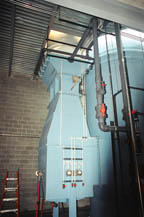
Then, housing developments began to spring up, and the new neighbors complained about the odors emitted during this process. "Since our goal is to be a good neighbor, as well as to operate a successful business, we worked with an environmental consultant to investigate cost-effective control technologies," says Dave Wisneski, project manager with International Ingredient. "The lactose-rich liquid resulting from cheese production is a dynamic solution that can biodegrade quickly, so we had only a short window to process the liquids."
He says the company evaluated its options and determined wet scrubbing equipment from Bionomic Industries would give a practical, effective control methodology, while meeting the stringent monitoring and timing requirements of processing. "Unlike other alternatives, wet scrubbing uses water as a medium to clean the air stream," says Wisneski. "This is ideal for our application because dairy-based products generate a residue that can easily clog filters or carbon plates, thus requiring additional cleaning."
With this wet scrubbing system, odors are controlled by first being absorbed into water and then being oxidized in water. Agents are used to provide further control. Since the oxidant also tends to attack the absorbed particulate, the gas scrubber is split into two separate stages with independent liquid circuits to minimize agent consumption. One is an absorber stage featuring a Bionomic Industry Rotabed gas scrubber for odor control; the other stage is a Bionomic Industries Series 7000 venturi scrubber for particulate removal.
Blowdown from the absorber stage is fed forward into the particulate stage. This means two passes can be made through the scrubber with the same water, reducing water consumption without diminishing efficiency.
Using the adjustable throat venturi scrubber, which operates at about 8-in w.c. pressure drip, over 99 percent of the incoming particulate is removed. The blower stage of the scrubber absorption tower houses a droplet eliminator stage for the venturi scrubber, which keeps its liquid isolated in that circuit. A recycle pump pulls liquid from the absorber sump and recycles it to the venturi scrubber. There, the liquid is shattered into tiny target droplets that bombard the particulate. These droplets are separated in the droplet control stage using a high-efficiency, chevron-type droplet eliminator.
Above the venturi droplet control stage, a trap separates the particulate stage liquid from that of the absorber stage. The absorber stage liquid drains to an external recycle tank equipped with its own pump and control. Using metering pumps connected to chemical storage tanks, sodium hypochlorite and caustic can be administered automatically based on pH or oxidation-reduction potential. However, at International Ingredient, further agent treatment is unnecessary.
A second chevron droplet control is used after the odor control absorption stage. The cleaned gases leave the scrubber via a stack. To save space, a blower was installed ahead of the gas scrubbing system, allowing the discharge stack to be placed on top of the Rotabed stage.
Following the installation of the Bionomic system, International Ingredient has successfully controlled gaseous and particulate borne odors-while meeting all Wisconsin DNR criteria, with outlet particulate loading under 0.006 grs/dscf, far below that state's allowable limit.
For more information:
John Enhoffer, Bionomic Industries,
www.bionomicind.com,
201- 529-1094


